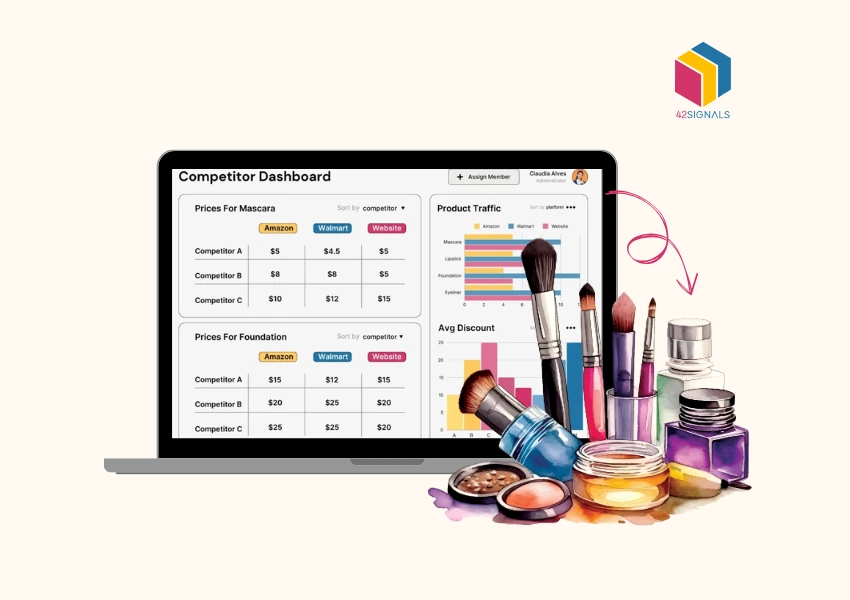Are you aware that 86% of consumers would spend more money simply for a superb customer experience? However, a lot of companies have yet to learn how to hear the voice of the customer through reviews, social media comments, and survey responses. Sure, that negative feedback feels like a punch in the gut. But what if I told you that it can be transformed into a goldmine of insights?
Welcome to consumer sentiment analysis, a revolutionary tool that helps brands to analyze customer feedback and take steps toward improving satisfaction. Here at 42Signals, we help brand managers, marketing specialists, and customer experience professionals harness the power of sentiment analysis to transform their brands.
In this guide, we are going to teach you how to use consumer sentiment analysis to increase customer satisfaction, improve products and services, and grow your brand.
What Is Consumer Sentiment Analysis?

Image Source: The Good
Consumer sentiment analysis is defined as the tracking, understanding, and evaluation of customers’ views and feelings toward a business, service, or product by using AI-enabled tools, software scraping, and natural language processing. Customer feedback from several sources like:
- E-commerce markets (Amazon, Walmart, eBay, etc.)
- Social media networks (Twitter, Facebook, Instagram, Linkedin)
- Review platforms (Trustpilot, Yelp, Google Reviews)
- Surveys and customer service
When a brand reviews how positive, negative, or neutral customer feelings are, identifies recurring problems, and takes action to satisfy customers’ needs, either through product improvement or other alternatives, business objectives are achieved.
Consider being a brand manager for an innovative e-commerce company. You recently introduced a new product to the market. Initially, there were strong sales, but over time, there was an unusual increase in negative reviews on Amazon. You do not consider the situation until an analysis is performed.
Upon reflection, the concern may be that consumers adore the item but are having problems with the package. The earlier you can locate these tendencies sentiment analysis helps, thus allowing you to manage or avert harm to your brand reputation.
Why Consumer Sentiment Analysis Matters for Brands?

Image Source: Needl
1. Identifying and Addressing Pain Points
Negative comments and feedback are inevitable for any brand out there. Instead of ignoring it, sentiment analysis gives the opportunity to detect recurring issues among customers and resolve them before they escalate. For instance, if customers frequently complain about “slow delivery,” the brand can implement advances in its logistical operations.
2. Enhancing Product Development
Identifying sentiment shifts helps companies understand which features are loved and which ones require revisions. This is particularly helpful in developing new products and services to meet the expectations of customers.
3. Measuring Brand Perception
Analyzing consumer sentiment allows businesses to understand the perception towards their brand within a specific duration. A sudden spike in negative sentiment after a product launch could be concerning, companies can delve further to understand the underlying issues.
4. Gaining Competitive Insights
Analyzing the brand sentiment of competitors reveals areas within the industry that are not served. If customers for a competitor brand are dissatisfied due to a lack of customer support, a business can optimize the brand’s services and consequently capture more customers.
5. Optimizing Marketing Strategies
Knowing what appeals to consumers enables brands to develop stronger communications as well as effective marketing campaigns. An advertising feature that is already positively viewed can be amplified to improve engagement and conversions in advertising.
Take, for example, 42Signals’ sentiment analysis tools, which scrape e-commerce review data from marketplaces such as Amazon, analyze them, and classify them as positive and negative. This way, you can quickly pinpoint where improvements are needed and address them.
How to Use Consumer Sentiment Analysis for Maximum Impact?
1. Collect Data from Multiple Touchpoints
The first step in analyzing sentiment is to try and collect feedback from console users. Businesses have to make use of tools that pull data from:
- E-commerce platforms (Amazon scrapers and Walmart data extractors)
- Social media monitoring tools
- Surveys customer feedback and NPS score forms
- Transcription of live chat sessions and email correspondence
42Signals offers website scraping solutions that allow brands to track customer sentiment by pulling feedback from different channels.
2. Categorize and Analyze Sentiment
When the information has been received, the next step would be to break the information into smaller constituents and interpret it as follows:
- Positive sentiment (ex. “I adore the super quick delivery and the customer support is fantastic!”)
- Negative Sentiment (“The product broke after two months of usage.”)
- Neutral sentiment (ex. “The item is worth the value.”)
Customer feedback analytics systems, particularly those offered by 42Signals, provide AI-based Analytics and interpretation geared towards customer feedback in bulk using machine learning and NLP.
3. Detect Emerging Trends and Patterns
If you assess sentiment over time, you are able to recognize patterns that are likely to impact a user’s satisfaction.
For Example: If there is a sudden escalation in negativity regarding sentiments towards a particular product’s packaging, it may signal a problem related to the chain supply.
The improvement in logistics is paying off for companies, as demonstrated by the sharply rising “fast shipping” positive mentions.
Improved operational strategies aimed to enhance customer happiness can and should rely on monitored trends.
4. Take Action Based on Insights
Sentiment insights provided an action strategy with a focus area, but that is insufficient. The brand needs to take important steps like:
- Addressing the improvements recurrence to fulfill customer requests.
- Looking into frequent customer pain points to improve customer services.
- Frequently referred inability to afford products must force an immediate change in pricing.
- Telescoping marketing communications to changes that customers adore.
Listening to clients with sentiments and preparing desired products can be done effectively by using “42Signals” real-time analytics.
5. Track Competitor Sentiment for Benchmarking
Knowing how brands are interpreted in relation to competitors is important for any company. By analyzing customer sentiment around competitive products, brands can:
- Find market opportunities and deploy their products most optimally.
- Collects negative lessons from adversaries to avoid bad outcomes.
- Position their brand to become associated with good customer service rather than poor brand experience.
With “42Signals” brand monitoring tools, brands can analyze competitiveness by tracking the sentiments in different e-commerce platforms continuously.
How Voice of Customer Analytics Drives Success in the Electronics Industry?
• Challenge
An electronics company selling on Amazon was faced with declining consumer ratings for their latest wireless headphones. Customer sentiment in the reviews was negative, which led to dip in sales during the product launch and subsequently caused a decrease in the brand’s ranking on the search results page.
• Solution

The brand used 42Signals’ consumer sentiment analysis which helped them pull data from:
• Amazon reviews to check what issues were repeatedly coming up.
• Social media posts to understand how customers were regarding the product.
• Competition analysis to see how other brands were performing.
The analysis identified that customers were satisfied with the sound quality and battery life, however, customers frequently complained of:
• Discomfort after extended periods of usage.
• Bluetooth connection issues with some devices.
To address these customer pain-points, the brand took immediate steps to:
• Improve ear padding comfort.
• Issue a firmware update that addressed the connectivity issue.
• Focus marketing campaigns on product benefits – sound quality & battery life.
• Outcome
The brand experienced an increase in positive brand sentiment, better ratings on Amazon, and an overall increase in sales within a few months. The brand was able to successfully use sentiment analysis to boost growth by listening to its customers and acting on the insights.
Conclusion
The analysis of consumer sentiment goes beyond being just another phrase; it is a tool that can be utilized for your business. The voice of customer analytics tells us how to resolve concerns while turning negative feedback into opportunities and how to build on positive sentiment to strengthen brand loyalty.
Here at 42Signals, we help you every step of the way. From website scraping to Amazon scraping and sentiment analysis, our tools have the relevant insights needed to improve customer satisfaction and boost your brand.Schedule a demo with us today to learn how consumer sentiment analysis will benefit your business.







